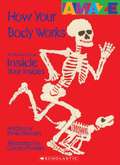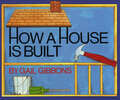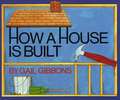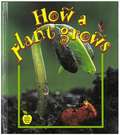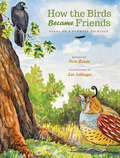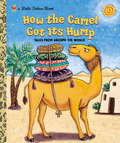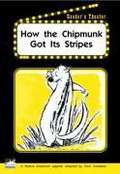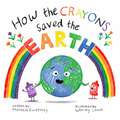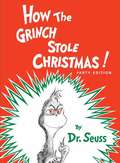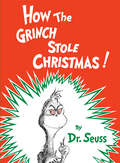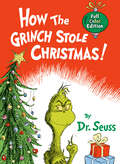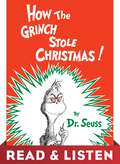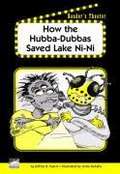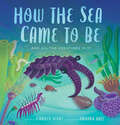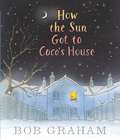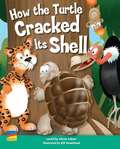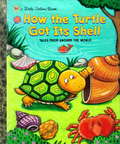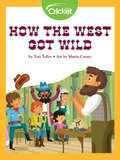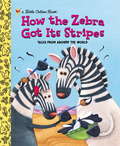- Table View
- List View
How You Got So Smart
by David MilgrimEvery stage in growing up has its own fun and challenges, and the adorable star of this book faces each one with gusto. As a baby, there's the taste-everything phase--whether it is meant to be eaten or not! And as a toddler, there's the question-everything phase. But all the while baby is growing up and becoming a curious kid whose exploration of the world leads to amazing places and discoveries. He's come so far and learned so much, and now everyone is so proud of him! This celebration of curiosity and creativity, with its funny, joyful illustrations full of kid-friendly details, is a great gift for any major milestone.
How Your Body Works: A Good Look Inside Your Insides
by David StewartWhat, Why, and How is explained with respect to human body.
How a City Works (Let's-Read-and-Find-Out Science 2)
by D. J. WardRead and find out about how cities work in this colorfully illustrated nonfiction picture book.Millions of people live in cities around the world, but have you ever wondered how cities work? All those people need clean water to drink, a safe place to live, and a way to get all around the city. How do you take care of all those people’s needs? Read and find out all about the systems a city has to help keep everyone safe, healthy, and happy.This book on city systems will appeal to the young civil engineer. How a City Works is filled with fun, accurate art, and includes tons of information. For example, it answers the question: Where does all the electricity needed to make a city run come from? How a City Works covers water treatment, power, sewage, recycling, and transportation.How a City Works comes packed with visual aids like charts, sidebars, an infographic, and a funny, hands-on activity—how to clean up dirty “sewage” water, using puffed rice cereal, raisins, hot chocolate mix, and coffee filters.This is a clear and appealing science book for early elementary age kids, both at home and in the classroom. It's a Level 2 Let's-Read-and-Find-Out, which means the book explores more challenging concepts for children in the primary grades. The 100+ titles in this leading nonfiction series are:hands-on and visualacclaimed and trustedgreat for classroomsTop 10 reasons to love LRFOs:Entertain and educate at the same timeHave appealing, child-centered topicsDevelopmentally appropriate for emerging readersFocused; answering questions instead of using survey approachEmploy engaging picture book quality illustrationsUse simple charts and graphics to improve visual literacy skillsFeature hands-on activities to engage young scientistsMeet national science education standardsWritten/illustrated by award-winning authors/illustrators & vetted by an expert in the fieldOver 130 titles in print, meeting a wide range of kids' scientific interestsBooks in this series support the Common Core Learning Standards, Next Generation Science Standards, and the Science, Technology, Engineering, and Math (STEM) standards. Let's-Read-and-Find-Out is the winner of the American Association for the Advancement of Science/Subaru Science Books & Films Prize for Outstanding Science Series.
How a House Is Built
by Gail GibbonsHouses are built with many different materials, and in many shapes and sizes. Step by step, this picture book explains how homes are built—from the architect's plans through the arrival of a happy family. The many processes of construction are explained with simple language and bright, clear illustrations, perfect for kids starting to wonder about how the world around them works. Many different careers—including carpenters, plumbers, electricians, and landscapers—are introduced, each doing their part to bring the picture wood-frame house to life. A great read for kids who love construction sites, or who can't get enough of Building a House by Byron Barton. According to The Washington Post, Gail Gibbons "has taught more preschoolers and early readers about the world than any other children's writer-illustrator." Ms. Gibbons is the author of more than 100 books for young readers, including the bestselling titles From Seed to Plant and Monarch Butterfly. Her many honors include the Washington Post/Childrens Book Fuild Nonfiction Award and the NSTA Outstanding Science Trade Book Award.
How a House is Built
by Gail GibbonsGail Gibbons uses clear, simple wording to present all the steps involved in building a house. From the architect who draws the plans, through the various types of workers who construct it, to the family who will make the house their home, each aspect is explained. Children can easily follow along as construction begins at the ground level with surveyors, describing the jobs of carpenters and plumbers. The many tools used to complete each task are explained, ultimately showing how all the workers' efforts come together to build a whole house from basement to roof, both inside and outside.
How a Seed Grows (Let's-Read-and-Find-Out Science 1)
by Helene J. JordanRead and find out about how a tiny acorn grows into an enormous oak tree in this colorfully illustrated nonfiction picture book.This is a clear and appealing environmental science book for early elementary age kids, both at home and in the classroom. Plus it includes a find out more activity section with a simple experiment encouraging kids to discover what a seed needs to grow.This is a Level 1 Let's-Read-and-Find-Out, which means the book explores introductory concepts perfect for children in the primary grades. The 100+ titles in this leading nonfiction series are:hands-on and visualacclaimed and trustedgreat for classroomsTop 10 reasons to love LRFOs:Entertain and educate at the same timeHave appealing, child-centered topicsDevelopmentally appropriate for emerging readersFocused; answering questions instead of using survey approachEmploy engaging picture book quality illustrationsUse simple charts and graphics to improve visual literacy skillsFeature hands-on activities to engage young scientistsMeet national science education standardsWritten/illustrated by award-winning authors/illustrators & vetted by an expert in the fieldOver 130 titles in print, meeting a wide range of kids' scientific interestsBook in this series support the Common Core Learning Standards, Next Generation Science Standards, and the Science, Technology, Engineering, and Math (STEM) standards. Let's-Read-and-Find-Out is the winner of the American Association for the Advancement of Science/Subaru Science Books & Films Prize for Outstanding Science Series.
How a plant grows (Crabapples)
by Bobbie KalmanHow A Plant Grows introduces children to the amazing lives of plants--from their beginnings, through their growth, to reproduction and death. Full-color illustrations and photographs accompany simple plant experiments.
How the Birds Became Friends
by Noa BaumA playful picture book with a powerful message from a national storyteller. With each bird desperate to prove himself superior to the others, can little Quail break the cycle with an act of kindness?
How the Camel Got Its Hump
by Katherine Scraper Lori O'Dea Juan Bautista Juan OliverNIMAC-sourced textbook
How the Camel Got Its Hump (Little Golden Book)
by Justine Fontes Ron Fontes Keiko MotoyamaWitty stories from around the world, and by the great writer Rudyard Kipling, "explain" how the camel got its hump. Fascinating facts about the camel round out this colorful book!
How the Chipmunk Got Its Stripes
by Jackie Urbanovic Pam Hirschfeld Staci SwedeenPerform this script about a Native American legend about how a chipmunk got its stripes.
How the Crayons Saved the Earth (How the Crayons Saved #5)
by Monica SweeneyWhat can crayons do to save the planet?Something is happening to our big green and blue Earth! Pollution is making it hard for plants to grow, for animals to play, and for oceans to stay clean. But what can anyone do about it? On a yucky, smoggy day, a box of seven special crayons steps up to help! These peppy crayons are on another adventure to bring friendship, teamwork, and thoughtfulness to the world—but this time, it&’s the world that needs help. With their unique personalities, quirky attitudes, and stick-to-itiveness, this rainbow of friends puts their heads and hearts together to find a way to save the Earth. How the Crayons Saved the Earth is a colorful book about the environment from the plucky crayons who brought you the How the Crayons Saved the Rainbow series. How the Crayons Saved the Earth reminds kids about the importance of taking care of the Earth and that teamwork and determination can make a real difference.
How the Grinch Stole Christmas
by Dr Seuss"Every Who down in Who-ville liked Christmas a lot... but the Grinch, who lived just north of Who-ville, did NOT!" Not since "'Twas the night before Christmas" has the beginning of a Christmas tale been so instantly recognizable. No holiday season is complete without the Grinch, Max, Cindy-Lou, and all the residents of Who-ville, in this heartwarming story about the effects of the Christmas spirit on even the smallest and coldest of hearts. Like mistletoe, candy canes, and caroling, the Grinch is a mainstay of the holidays, and his story is the perfect gift for young and old. Images and image descriptions available.
How the Grinch Stole Christmas (Classic Seuss)
by Dr. SeussGrow your heart three sizes and get in on all of the Grinch-mas cheer with this Christmas classic--the ultimate Dr. Seuss holiday book that no collection is complete without! Every Who down in Who-ville liked Christmas a lot . . . but the Grinch, who lived just north of Who-ville, did NOT! Not since "'Twas the night before Christmas" has the beginning of a Christmas tale been so instantly recognizable. This heartwarming story about the effects of the Christmas spirit will grow even the coldest and smallest of hearts. Like mistletoe, candy canes, and caroling, the Grinch is a mainstay of the holidays, and his story is the perfect gift for readers young and old. "Irrepressible and irresistible." --Kirkus Reviews
How the Grinch Stole Christmas!
by Dr Seuss<p>“Every Who down in Who-ville liked Christmas a lot . . . but the Grinch, who lived just north of Who-ville, did NOT!” Not since “’Twas the night before Christmas” has the beginning of a Christmas tale been so instantly recognizable. This heartwarming story about the effects of the Christmas spirit will grow even the coldest and smallest of hearts. Like mistletoe, candy canes, and caroling, the Grinch is a mainstay of the holidays, and his story is the perfect gift for young and old. <p>And don't forget to celebrate Grinch-mas this Christmas season, the annual holiday tradition inspired by How the Grinch Stole Christmas that encourages readers to grow their hearts three sizes by doing good deeds!</p>
How the Grinch Stole Christmas! Full Color Edition (Classic Seuss)
by Dr. SeussGrow your heart three sizes—and dazzle your eyes—with this FULL COLOR edition of the beloved holiday classic How the Grinch Stole Christmas!—perfect for Dr. Seuss fans and collectors any time of year!This season of giving, give a gift that's never been given before—a full color edition of How the Grinch Stole Christmas! Originally published in 1957 using just 2 different colored inks (red and black), this edition features Dr. Seuss's original illustrations in full color for the very first time—the way he'd have likely colored them had he published the book today! While this edition is not a replacement for the original, it makes a cheerful addition to the Dr. Seuss canon that is bound to appeal to Dr. Seuss fans of all ages. PS: The drabness of the Grinch's life in his cave compared to the happy, vibrant life of the Whos in Who-ville has never been easier to see!
How the Grinch Stole Christmas! Read & Listen Edition (Classic Seuss)
by Dr. Seuss&“Every Who down in Who-ville liked Christmas a lot . . . but the Grinch, who lived just north of Who-ville, did NOT!&” Not since &“&’Twas the night before Christmas&” has the beginning of a Christmas tale been so instantly recognizable. No holiday season is complete without the Grinch, Max, Cindy-Lou, and all the residents of Who-ville, in this heartwarming story about the effects of the Christmas spirit on even the smallest and coldest of hearts. Like mistletoe, candy canes, and caroling, the Grinch is a mainstay of the holidays, and his story is the perfect gift for young and old. This Read & Listen edition contains audio narration.
How the Hubba-Dubbas Saved Lake Ni-Ni
by Jeffrey Fuerst Anne Flounders Anita DufallaPerform this script about two tribes that must learn to live and work together.
How the Sea Came to Be: (And All the Creatures In It)
by Jennifer BerneA lyrical, spectacular history of the ocean—from its dramatic evolutionary past to its marvelously biodiverse present.&“For millions of years these first bits of lifeBecame more, and then more, and then more.&”Long, long ago, when the Earth was young and new, the world was a fiery place. Volcanoes exploded from deep down below, and steamy, hot clouds rose up high. Rain poured down for thousands of years, filling the world&’s very first oceans. There the teeniest stirrings of life began. Earth&’s creatures grew bigger and bigger, evolving into exciting forms like jellyfish, coral, and worms. Millions of years passed. Down in the depths and up on the surface, ocean life grew and spread. Now the sea teems with all kinds of animals—squid, turtles, dolphins, barracudas, even glowing fish, all living in the waters where long, long ago, life itself came to be. Spanning 4.5 billion years of evolution, this extensively researched book is an accessible introduction to geology, oceanography, and marine biology. Entrancing verse, awe-inspiring art, and fascinating back matter capture the mysterious beauty of the ocean and the incredible organisms who call it home.
How the Sphinx Got to the Museum (How The ... Got To The Museum)
by Jessie HartlandDepicts how the Sphinx was commissioned by the Pharaoh, was built, was rediscovered after centuries and then travelled to New York.
How the Sun Got to Coco's House
by Bob GrahamFollow the journey of the sun across the world from a whale’s eye to a little girl’s window in Bob Graham’s tender, transcendent story. <P><P>While Coco sleeps far away, the sun creeps over a hill and skids across the water, touching a fisherman’s cap. It heads out over frozen forests, making shadows in a child’s footprints, and balances on an airplane’s wing for a little boy to see. The sun crosses cities and countrysides, wakes furry creatures, makes a desert rainbow, and barges into Coco’s room to follow her through a day of play. With an eye for capturing small moments of shared experience, Bob Graham illuminates the natural wonder that comes with every new day. <P><P>Lexile Measure: AD650L
How the Turtle Cracked Its Shell
by Bill Greenhead Alison Adams Sera Y. ReycraftDid you ever wonder why a turtle's shell isn't one smooth piece? Read this pourquoi tale to find out!
How the Turtle Got Its Shell (Little Golden Book)
by Justine Fontes Ron Fontes Keiko MotoyamaDelightful retellings of turtle tales from around the world, plus fun facts about turtles, are sure to please all turtle fans.
How the West Got Wild
by Tori TelferChummy and Sandra Bee were the rowdiest little kids in Ruby, Arizona. But when they helped start the gold rush in Ruby, people stopped calling them "wild" and "rambunctious" and started calling them "plucky" and "clever."
How the Zebra Got Its Stripes (Little Golden Book)
by Ron Fontes Golden BooksAs a group of African animals hang out at the local watering hole, they share funny stories about how the zebra got its stripes. At the end of the book, fun facts explain why zebras really have stripes. For any child intrigued by zebras, this colorful, informative book is a must!

